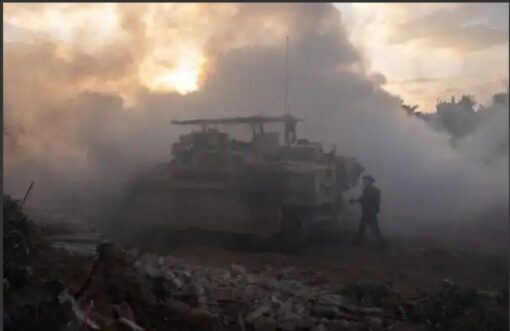The southern Israeli city of Eilat was rocked on Wednesday when a drone launched from Yemen slammed into the Red Sea resort town, injuring at least 22 people and exposing the vulnerabilities of Israel’s air defense systems.
Emergency services confirmed that two victims sustained life-threatening wounds from shrapnel, while others suffered moderate to light injuries. Authorities warned residents to avoid the crash site as bomb disposal units combed through debris that may have contained explosive materials.
The attack, which has been claimed by Yemen’s Houthi movement, represents the latest escalation in a widening regional conflict fueled by Israel’s ongoing war in Gaza.
Houthis Claim Responsibility
Houthi military spokesperson Yahya Saree said the assault was carried out using multiple drones aimed at Israeli military and civilian sites in Eilat and Be’er Sheva. Saree described the operation as “successful,” framing it as part of the group’s campaign of solidarity with Palestinians.
Since late 2023, the Houthis have positioned themselves as a frontline force against Israel, conducting dozens of long-range drone and missile operations. While many of these attempts were intercepted or fell short, the strike on Eilat underscores both the persistence of the group and the limits of Israel’s defense shield when facing repeated barrages.

Israeli Air Defenses Under Scrutiny
The Israeli military acknowledged that its interception system failed to neutralize the incoming drone. This marks the second such incident in recent weeks, raising sharp questions about the country’s preparedness.
Defense analysts have pointed out that Israel’s Iron Dome and David’s Sling systems were primarily designed to counter shorter-range rockets fired from Gaza or Lebanon. Drones launched from over 1,500 kilometers away present new challenges, particularly when deployed in swarms or combined with decoys.
For residents of Eilat, the failure of interception was particularly unsettling. “We rely on these systems to protect us, but twice in two weeks we’ve seen them fail,” said one resident, describing the atmosphere in the normally tranquil resort town as “deeply anxious.”
Escalation Beyond Gaza
The Houthis’ targeting of Israel reflects how the Gaza conflict has spilled across the region. In the Red Sea, the group has harassed commercial vessels linked to Israel and the West, severely disrupting one of the world’s most vital maritime corridors. Insurance premiums for shipping through the waterway have soared, while global trade routes have been forced into costly detours.
Israel has retaliated with multiple airstrikes on Yemen in recent months, hitting the capital Sanaa and strategic Red Sea ports. These strikes have caused heavy casualties, including the death of senior Houthi officials.
Late last month, the assassination of Houthi Prime Minister Ahmed al-Rahawi and several cabinet members in an Israeli strike further inflamed tensions. The Houthis pledged revenge, with Wednesday’s drone attack seen as part of that promise.
International Reactions
The strike on Eilat reverberated far beyond Israel. Regional powers expressed alarm that the conflict is expanding into new theaters. Gulf states, already wary of the Houthis’ growing capabilities, voiced concerns about instability along the Red Sea trade route.
Western governments condemned the attack while reiterating their support for Israel’s right to defend itself. However, some European diplomats urged restraint, warning that Israeli retaliation risks deepening an already volatile situation in Yemen.
Human rights groups, meanwhile, highlighted the humanitarian disaster unfolding in both Gaza and Yemen. “This is a conflict that has no borders,” said one rights advocate. “Civilians are paying the highest price, whether in Gaza under bombardment or in Yemen facing airstrikes.”
Civilian Impact in Eilat
For Eilat’s residents and tourists, the attack shattered a sense of safety in one of Israel’s most popular holiday destinations. Known for its Red Sea beaches and coral reefs, the city rarely experiences direct strikes compared to areas closer to Gaza or Lebanon.
Hospital staff described chaotic scenes as ambulances rushed in with shrapnel victims. Local businesses closed their doors, and authorities instructed the public to adhere strictly to Home Front Command guidelines. Schools in the area announced closures until further notice.
A hotel worker described the panic as sirens wailed too late to prevent the drone’s impact. “We heard a massive blast, and then the windows shattered,” he said. “Guests were screaming, running to the shelters. It felt like the war had reached us directly.”
Broader Regional Dynamics
The Houthi campaign against Israel fits into a larger pattern of Iran-backed groups applying pressure on Israeli and Western interests. Alongside Hezbollah in Lebanon and militias in Iraq and Syria, the Houthis have become part of a loose but coordinated front aimed at stretching Israel’s military capacity.
Analysts argue that this strategy has two goals: to project solidarity with Palestinians while also complicating Israel’s regional and international alliances. The fact that drones could bypass Israeli defenses also sends a symbolic message about the limits of technological superiority.
Some experts warn that continued Israeli strikes inside Yemen may pull the region into a more sustained confrontation, potentially involving Iran directly. With maritime trade already under strain and global oil markets jittery, the strategic stakes extend well beyond the battlefield.

As investigations continue into why Israel’s defenses failed again, pressure is mounting on Prime Minister Benjamin Netanyahu’s government to provide answers. Opposition politicians have accused the government of neglecting southern communities, while military officials insist that improvements to interception systems are underway.
For the Houthis, the strike represents not just a military operation but also a propaganda victory. Videos circulated online showed their supporters celebrating what they called a blow against “Israeli aggression.”
Yet the cost of escalation is steep. Yemen remains one of the world’s most fragile states, devastated by years of civil war, famine, and foreign intervention. Each new Israeli strike deepens the country’s suffering, while retaliatory Houthi attacks risk dragging the wider region into conflict.
The drone strike on Eilat marks a dangerous turn in the conflict, signaling both the Houthis’ determination and Israel’s vulnerabilities. With 22 people wounded and an entire city shaken, the incident underscores how a war that began in Gaza now reverberates across the Middle East.
Whether Israel responds with intensified operations in Yemen or recalibrates its defenses at home, the risk of further escalation looms large.
For civilians in both Eilat and Sanaa, however, the reality is already grim: the frontlines of war are expanding, and safety feels increasingly out of reach.


